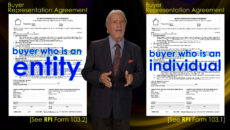This article discusses the need for carryback sellers to negotiate a waiver of the senior lender’s due-on clause on a sale subject to its trust deed loan.
Prior planning prevents a call
A seller of real estate encumbered with a first trust deed lists the property for sale with his broker. The trust deed contains a due-on clause.
Later, the broker presents the seller with a purchase offer from a buyer on terms which include:
a cash down payment;
an assumption of the existing first trust deed by the buyer; and
a carryback note executed by the buyer in favor of the seller for the balance of the purchase price, to be secured by a second trust deed on the property.
| The seller accepts the offer, and a sales escrow is opened. As part of their instructions, escrow then requests a loan assumption package from the lender who holds the note secured by the existing trust deed.Before the close of escrow, the lender approves the sale on one condition: the buyer assumes the loan obligation and agrees to a modification of the interest rate and payment schedule in the note. | By consenting to the conveyance of secured property, the lender has, by its conduct, waived its rights under the due-on clause. |
The buyer agrees to the lender’s demands and signs a loan assumption and note modification agreement. The lender does not enter into a written agreement with the seller regarding the carryback second trust deed. However, the lender did receive a copy of the escrow instructions during the loan assumption process which discloses the carryback second trust deed as part of the sales transaction.
Here, by consenting to the conveyance of the secured property to the buyer on the terms of the escrow instructions, the lender has, by its conduct, waived its rights under the due-on clause regarding the further encumbrance carried back by the seller. [Rubin v. Los Angeles Federal Savings and Loan Association (1984) 159 CA3d 292]
However, the lender has not entered into a written agreement to waive its due-on right to call or recast the loan should the buyer later transfer an interest in the property while the carryback seller still holds his second trust deed or the seller forecloses.
After the buyer takes title, a transfer of any interest in the secured real estate by the buyer will require the lender’s prior consent to avoid triggering the due-on clause, except for a lease with a term under 3 years and the personal residence exceptions.
On the later transfer of any interest by the buyer, the lender has the right on each transfer to:
accelerate (call) the balance of the loan; or
recast the loan, demanding modifications in the note and a fee as a condition for allowing an assumption or other waiver of the due-on clause.
The underlying lender can call the loan or demand the note be recast, with exceptions for the conveyance of a personal residence to family members or for any equity loan encumbrance if, after escrow closes, the buyer:
dies;
conveys or further encumbers the property;
enters into a long-term lease or a lease with a purchase option; or
defaults on the carryback note and causes the seller to complete a foreclosure sale, etc.
The written waiver
A typical carryback sales transaction is structured as either:
a standard second trust deed and note with the underlying lender consenting to the conveyance of the property and the recording of a carryback second by waiving its due-on clause in exchange for an assumption fee and modification of the note by the buyer; or
an all-inclusive second trust deed (AITD) and note, or another wraparound security device, with the underlying lender consenting to the conveyance to the buyer and the carryback AITD by waiving its due-on clause in exchange for a modification of the trust deed note and payment of fees by the seller – all in lieu of the buyer’s assumption of the loan, an activity sometimes called a reverse assumption.
The waiver agreement ensures the carryback seller can protect his security interest in the title without due-on interference from the underlying lender. | After the lender consents to the carryback sale and escrow closes, future events beyond the seller’s control can again trigger the due-on clause.A carryback seller, like any junior trust deed holder, must be made aware and understand a due-on clause in the underlying trust deed gives the lender the absolute right to call the loan on a future transfer of any interest in the property by the buyer. The lender’s call is restricted only on short-term leases on any type of property, on inter-family transfers or the further encumbrance of owner-occupied, four-or-less residential properties. |
Without the lender’s prior written waiver of its due-on enforcement rights, triggered by future transfers, the lender can call the loan due on the transfer of an interest in the property by the buyer, such as on a resale, further encumbrance, lease for over three years, court-ordered transfer, foreclosure, death, etc. – again with some exceptions for conveyance of the principal residence.
A written waiver of the lender’s future enforcement of the due-on clause bars the lender from calling the loan and protects the carryback seller for as long as the seller has an interest in the property. The waiver agreement ensures the carryback seller can protect his security interest in the title without due-on interference from the underlying lender.
To best protect the seller’s trust deed, the seller should have the lender waive its right to call the loan:
on the conveyance and further encumbrance of the property on close of the carryback sale;
for as long as the carryback trust deed remains of record; and
on the carryback seller’s reacquisition of title to the property should the seller have to complete a foreclosure on the property or accept a deed-in-lieu of foreclosure.
To be enforceable against the lender, the waiver must be in writing. [12 Code of Federal Regulations §591.5(b)(4)]
AITD and waiver
The AITD carryback is merely a variation on the standard carryback second trust deed. An AITD is also a junior trust deed, typically a second.
However, in contrast to the standard trust deed, the AITD:
secures a note for a principal amount which totals the unpaid balances on underlying liens and the balance of the seller’s equity remaining unpaid after a down payment;
obligates the carryback seller to continue making payments on the underlying liens; and
does not involve an assumption of the underlying (wrapped) loan by the buyer.
However, the creation of the AITD, recorded or not, still triggers the due-on clause since it is a further encumbrance of the real estate.
Prior to closing an AITD sale, it is the seller, not the buyer, who negotiates the modification of the existing first trust deed note and arranges for the payment of any fees demanded by the lender to waive the due-on clause. The note modification by the seller increases the lender’s portfolio yield through an increase in interest rates and monthly payments, as though the buyer had assumed the loan. A modification fee will be demanded of the seller in lieu of a buyer’s assumption fee.
Thus, the lender of record receives the same economic benefits of fees and market rates on the seller’s modification of its loan as though the buyer had assumed (and modified) the loan.
In exchange for the fees and modification, the lender consents to the seller’s AITD financing. As part of the negotiations, the lender agrees in writing to waive its rights under the due-on clause for as long as the carryback seller holds an interest in the property.
The carryback seller retains the responsibility of paying the principal and interest installments and any impounds due the lender on the underlying loan. Thus, the lender avoids the credit review of the buyer since the seller remains solely responsible for the payments.
After closing, instead of making payments on the underlying loan, the buyer makes installment payments on the AITD note directly to the carryback seller. On receiving installment payments on the AITD from the buyer, the carryback seller pays the installment due on the underlying trust deed and keeps any remaining amount as his own funds.
Broker’s duty to advise
| The brokers negotiating the carryback of a junior trust deed by a seller must inform the buyer and seller of risks posed by the due-on clause in the underlying loan. After a review of the due-on risks, the transaction is structured either to require the lender to consent to the transfer and carryback financing, called a waiver, or to require the buyer to take title subject to the existing trust deed. [See first tuesday Form 150 §4]Also, the carryback seller must understand a default by the buyer on AITD installments will force the seller to advance the delinquent installment to the underlying lender. If the installment payment is not advanced, the seller risks having his AITD wiped out by the lender’s foreclosure, a result no different than what would have occurred had the seller carried back a standard second trust deed. | A broker’s failure to advise the seller and the buyer of the existence and nature of any due-on clause will subject the broker to liability to both the buyer and seller for any due-on related loss of their financial expectations. |
A broker’s failure to investigate the provisions in a trust deed that remains of record and to advise the seller and the buyer of the existence and nature of any due-on clause, whether payments remain the seller’s responsibility or become the buyer’s responsibility, will subject the broker to liability to both the buyer and seller for any due-on related loss of their financial expectations.
For example, a buyer who is qualified to make payments on both the existing trust deed and a carryback note presents an offer to purchase property through the seller’s listing broker.
The purchase offer provides for a small cash down payment with the buyer taking title subject to the existing trust deed. The seller will carry back a note for the balance of the purchase price. The seller accepts the offer.
However, the buyer is not advised the recorded trust deed contains a due-on clause. Since an assumption of the loan by the buyer will not occur, a beneficiary statement is not ordered. A beneficiary statement would have disclosed the existence of the due-on clause to the buyer prior to closing. [Calif. Civil Code §2943]
After escrow closes, the first trust deed lender discovers the sale and calls the loan due. The buyer, unable to pay the balance due on the first trust deed, ultimately loses the property through the subsequent foreclosure sale.
The buyer seeks to recover his losses from the seller’s listing broker, claiming the broker had a duty to investigate and disclose the existence of the due-on clause.
The broker claims he owed no duty to the buyer to investigate or disclose title conditions contained in the recorded trust deed as the buyer was not his client.
Can the buyer collect his losses from the seller’s listing broker?
Yes! Any broker negotiating a transaction as an agent for either party must disclose title conditions affecting ownership or use of the property to both parties, not merely to his own client.
A due-on clause in a trust deed is a title condition directly affecting ownership of the real estate. The clause affects the buyer’s ability to maintain financing of the acquisition and ownership of the property. Thus, the seller’s broker has a general duty to disclose the existence of a due-on clause to both parties. [Pepitone v. Russo (1976) 64 CA3d 685]
Waiver negotiations
The seller’s listing broker can lessen the seller’s risk of loss on a carryback sale by negotiating and obtaining a written waiver of the existing lender’s future due-on rights, prior to closing the carryback sales transaction.
A broker negotiating a carryback sale structured as an AITD or other wraparound financing agreement also needs to anticipate the lender’s demand for increased interest and payments in exchange for a waiver of its due-on clause.
The interest rate and payment schedule negotiated for the AITD note should equal or exceed the interest rate and payment schedule the existing lender will demand as a modification of its note in exchange for its consent to the sale and any waiver of the lender’s future use of the due-on clause.
If, at the time the AITD carryback sale is negotiated, market interest rates are the same or lower than the interest rate on the underlying loan, the lender will be inclined to retain the original rate and demand only an assumption fee, often expressed in terms of points, for consenting to the seller’s AITD sales transaction.
Conversely, in a rising interest rate market when the existing lender’s note rate is below market interest rates, the lender is certain to use the due-on clause to take advantage of the higher current rates and increase the note rate (and their yield) on the buyer’s assumption – or on the seller’s modification in the case of an AITD.
The AITD purchase agreement should specify the terms for modification of the existing loan which are acceptable to both the buyer and the seller, placing limitations on the interest, monthly payments, due date, and assumption fee to be negotiated by the seller with the lender. Alternatively, the purchase agreement can include a contingency for the seller’s further approval of the modification demands by the lender to avoid impairing his AITD.
The carryback seller or his broker will need to negotiate the assumption or modification agreement with the lender, as well as any waiver of the lender’s exercise of its due-on rights for as long as the seller retains an interest in the property.













